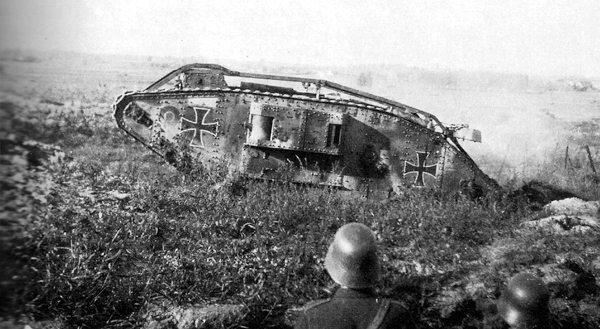
A captured British Mark IV female rearmed with German Maxim machine guns. The redeployment of British tanks by the German Army meant Allied aircraft sometimes mistakenly attacked their own tanks.
Thanks to the British naval blockade the German population was suffering by 1918. German submarines had failed to starve Britain into submission or stop the shipping of American forces to the Western Front. Gathering his last reserves, Ludendorff gambled on a knockout blow against the British who he considered the most vulnerable. If this could be achieved the Allies might sue for peace and bring an end to the conflict.
Even by this stage of the war the German High Command was not receptive to the tank. From their perspective those deployed by the British and French had not achieved truly decisive results. They decided what was needed was better infantry tactics that would allow for greater initiative and individual firepower.
The Germans felt that the anti-tank rifle, submachine gun and light machine gun offered much better prospects for achieving a breakthrough. In 1918 they produced the first purpose-built anti-tank rifle called the Mauser T-Gewehr. It fired a 13mm round and was based on big-game hunters’ elephant guns. This was issued to specially-formed anti-tank detachments whose job was to hunt down tanks.
Nonetheless, a rudimentary tank programme was instigated. The first German tank, the unwieldy A7V Sturmpanzerwagen, went into production in October 1917. Although 100 were ordered only twenty had armoured bodies as the rest were used as cargo-carriers. With a crew of seventeen, the A7V was a lumbering armoured box armed with a 57mm Maxim-Nordenfelt gun mounted at the front and six 7.92mm machine guns. It bore a greater resemblance to the French box-type heavy tanks than to the British rhomboid design. This was surprising as the Germans operated British tanks. Weighing some 33 tons when combat-loaded, the A7V could manage a top cross-country speed of 4mph and a range of about 20 miles.
The Sturmpanzerwagen was little more than an armoured gun platform for infantry support. As a result the design suffered from all the same problems that plagued the French St-Chamond and Schneider tanks. Its shape and size meant it was very poorly balanced and as the engine was underpowered it had very poor cross-country capability. A female variant was designed with two machine guns replacing the main armament, but only one of these saw combat before being converted to take the 57mm gun. As the Germans only had a handful of A7Vs they were not really a factor in their Spring 1918 offensive. Instead they relied on their new infantry tactics to carry them through.
Peace with Bolshevik Russia permitted Ludendorff to redeploy fifty divisions from the Eastern Front. Crucially these included troops trained in the latest infiltration tactics. They employed a new type of soldier dubbed the ‘stormtrooper’, some armed with the new Bergmann MP18 submachine gun. The stormtroopers moved swiftly through enemy lines leaving strongpoints to be mopped up by subsequent waves of infantry. General Oskar von Hutier devised these new tactics (from which the Nazi concept of Blitzkrieg or lightning war was to evolve) and they were first used on the Eastern Front at Riga in 1917.
By March Ludendorff had massed sixty-three divisions facing the 56-mile long sector between Arras and St Quentin held by the British 5th and 3rd Armies. These mustered just twenty-six divisions – Gough’s 5th Army was spread especially thinly in the south where it had been deployed to recuperate after its mauling at Passchendaele. Although better organized, Byng’s 3rd Army, which lay to the north, would be exposed if 5th Army gave ground.
On 21 March 1918 some 9,000 artillery pieces and mortars heralded the German Michael offensive. This was the opening stage of a whole series of attacks designed to crack open the Western Front. General von Hutier’s 18th Army set about the Gough’s 5th Army while General Georg von de Marwitz attacked Byng’s 3rd Army. The A7V proved mechanically unreliable and when five went into action on the 21st north of the St Quentin Canal three broke down.
Despite advancing up to 40 miles in places, within a week the Germans began to lose momentum. By 28 March Hutier had come to a temporary halt and by 5 April Marwitz had been stopped by British and Australian troops at Villers-Bretonneux some 10 miles short of his objective, Amiens. In two weeks of fighting Ludendorff suffered 250,000 casualties, which included a large number of his elite stormtroopers. Nonetheless, keeping the pressure up, on 9 April Ludendorff launched Operation Georgette to the north against Flanders with the aim of threatening the Channel ports.
The Allies reeled back in two areas under the shock of the German offensives. Ludendorff gained some ground south of Dunkirk and north of Arras. South of Arras, though, he achieved an even greater penetration extending to Reims. Allied tanks deployed in the defence were used as mobile pillboxes, which posed little problem for the highly-mobile stormtroopers. However, when the tanks were combined they greatly helped in stemming the German tide.
If Ludendorff succeeded in taking Villers-Bretonneux plus the high ground between there and Cachy then German artillery would be able to dominate Amiens. The French alert to the danger moved forces including the French Foreign Legion to Bois de Blangy about four miles west of Villers-Bretonneux along with A Company, 1st Tank Battalion of the British Tank Corps. The tanks were deployed to conduct ‘Savage Rabbit’ tactics whereby they lay in ambush positions ready to surprise infiltrating enemy troops. A Company was equipped with patched-up Mark IVs. No. 1 Section was commanded by Captain J. C. Brown, MC with three tanks – two female and one male. The single male was commanded by 2nd Lieutenant Frank Mitchell. Apart from its short 6-pounder guns and no steering tail it was little different in appearance to the original Mark I.
A second British tank type was involved in the coming battle – consisting of seven British Medium A Whippets from C Battalion, Tank Corps under Captain T.R. Price. At 14 tons, the Whippet required a crew of three, was armed only with four machine guns and could manage 8mph. This was Britain’s answer to the FT-17, although it was twice the weight of the French tank and required an extra crewman.
Captain Brown’s tanks were given a warm reception when they moved into the woods just to the north of Cachy. On the night of 23 April a German spotter plane flew over the Bois l’Abbe and dropped flares. These were followed by high-explosive rounds and mustard gas shells, which forced No.1 Section to withdraw to the western edge of the woods.
By this stage the Germans were short of troops and ammunition, which precluded anything more than a spoiling attack in the Villers-Bretonneux and Cachy area. However, they had fourteen A7V Sturmpanzerwagen available for the operation. These were divided into three groups, with the first comprising three tanks heading for Villers-Bretonneux, the second made up of seven tanks on the right flank heading for Bois d’Aquenne, and the third with four tanks driving on Cachy.
In the meantime two of Lieutenant Mitchell’s crew were overcome by gas and had to be evacuated. Nearby wounded infantrymen informed Brown and Mitchell that enemy troops were in Villers-Bretonneux. It was decided that they would counter-attack under the covering fire of a battery of 18-pounder guns in the area.
At 0845 on 24 April 1918 Brown set off in Mitchell’s tank, which deployed nearest the woods with the two female tanks on the right. ‘As the wood was still thick with gas we wore our masks’, recalled Mitchell, ‘while cranking up a third member of my crew collapsed and I had to leave him behind propped up against a tree trunk’. A crewman from one of the females was sent over to help, but Mitchell was still two crew short.
At 0930, when they reached the defences of the Cachy Switch Line, an infantryman warned them of the presence of German tanks. Mitchell saw three objects heading toward eastern Cachy followed by enemy infantry. The fourth German tank with the group, called Elfriede, had got lost in the fog, veered north and fallen into a quarry. Captain Brown ran to warn the females while Mitchell swung right to move parallel to the nearest German tank under 2nd Lieutenant Wilhelm Biltz called Nixe.
Mitchell’s left-hand 6-pounder began to fire on Nixe but there was no response, while his forward Lewis gun opened up on the German infantry. He then turned his tank to face the Germans. Mitchell later wrote: ‘Suddenly there was a noise like a storm of hail beating against our right wall and the tank became alive with splinters. It was a broadside of armour-piercing bullets. . . . The crew lay flat on the floor. I ordered the driver to go straight ahead and we gradually drew clear, but not before our faces were splintered. Steel helmets protected our heads.’
Lieutenant Biltz had put his tank into reverse and opened up with everything he had. Mitchell, hoping to get a clear shot, halted but this convinced Biltz the British tank was knocked out so he turned on the two females. He hit both, ripping holes in their armour and forcing them to withdraw.
In the meantime Mitchell rumbled forward, recalling that at 1020, ‘The gunner ranged steadily nearer and then I saw a shell burst high up on the forward part of the German tank. It was a direct hit. He obtained a second hit almost immediately lower down on the side facing us and then a third in the same region. It was splendid shooting for a man whose eyes were swollen by gas and who was working his gun single-handed, owing to the shortage of crew.’
Biltz’s crew were in a bad way. Mitchell’s first hit had killed the front gunner, mortally wounded two others and injured a further three. Afraid that a box of hand grenades might explode, the crew bailed out. However, Mitchell’s other two hits did little damage and Nixe’s engines continued running. Biltz and his crew returned to their tank and drove 1.25 miles before the engines seized up through lack of oil.
Mitchell engaged the other two A7Vs and when they withdrew southwards he assumed he had seen them off. He then continued to patrol the Switch Line and shelled the German infantry. It was at 1100 that the Whippets entered the fray, driving from northern Cachy and into the midst of the enemy infantry. Firing their machine-guns, they scattered the Germans left and right.
Captain Price had been informed incorrectly, as it transpired, that he was attacking unsupported enemy soldiers. Instead he ran into the other two A7Vs, Schnuck commanded by 2nd Lieutenant Albert Mueller and Siegfried under 2nd Lieutenant Friedrich-Wilhelm Bitter. The latter moved forward and opened fire along with supporting artillery. Price’s tanks had no way of defending themselves against the A7Vs’ 57mm guns. Suddenly one of the Whippets lurched to a halt with smoke pouring from it and a second burst into flames. It is unclear who hit them, but this unexpected resistance had the desired effect. The rest of the Whippets then began to withdraw on Cachy but only three made it undamaged after two of them broke down.
Lieutenant Mitchell’s luck also ran out. He had already been accidentally bombed by a friendly aircraft that thought his tank was German. This error is perhaps easy to understand in light of the Germans redeploying captured Mark IVs. Spotting a German tank at a range of some 1,000 yards Mitchell opened fire, but this drew the attention of a German mortar crew. ‘We had been hit at last’, recalled Mitchell, ‘We got out and made for the nearest trench some 50 yards back. It was about 12.45pm.’
For his bravery during the engagement between Cachy and Villers-Bretonneux, Mitchell was awarded the Military Cross, while his right-hand gunner Sergeant J. R. Mckenzie received the Military Medal. Mitchell’s citation read:
For most conspicuous gallantry and devotion to duty in action against enemy tanks at Cachy on April 24, 1918. This officer was in command of a male tank in action east of the Cachy Switch Line, when hostile tanks came in action. He fought his tank with great gallantry and manoeuvred it with much skill in order to bring the most effective fire on the enemy one, but to avoid offering a greater target than possible. As a result of his skilful handling of his tank and his control of fire, he was able to register five direct hits on the enemy tank and put it out of action. Throughout he showed the greatest coolness and initiative.
Villers-Bretonneux showed the Mark IV and Whippet to be far more manoeuvrable than the unwieldy Sturmpanzerwagen. However, the females and the Whippets armed with just machine guns were unable to fight them on anything like equal terms. This meant only Mitchell’s male Mark IV was able to take on the three AV7s. The world had witnessed its very first tank versus tank battle.

A captured British Mark IV female rearmed with German Maxim machine guns. The redeployment of British tanks by the German Army meant Allied aircraft sometimes mistakenly attacked their own tanks.
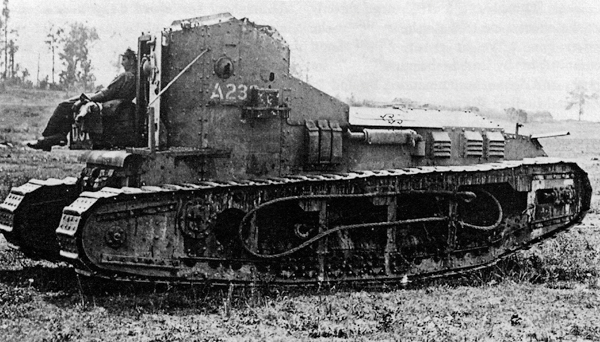
The Medium Mark A Whippet tank came into service in 1918. It was designed by William Tritton and built by Fosters of Lincoln. Although only armed with machine guns it was capable of twice the speed of the Mark IV.
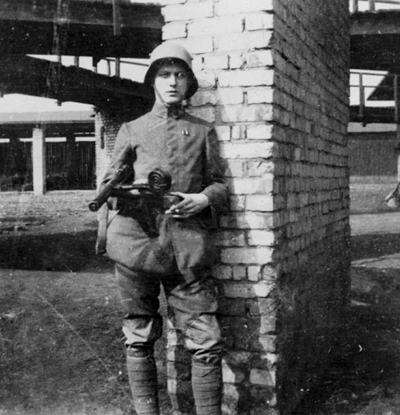
The German High Command was very slow to adopt the tank placing their faith instead in the stormtrooper for victory. This young stormtrooper is armed with the Bergmann MP18 submachine gun introduced in 1918. The round object is the 32-round ‘snail’ magazine used on the Luger semi-automatic pistol, which was adapted for the MP18.
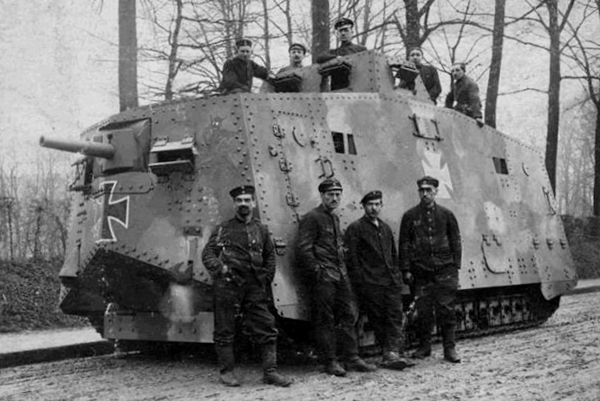
The German A7V Sturmpanzerwagen went into production in October 1917, but only twenty of these cumbersome land fortresses were built.
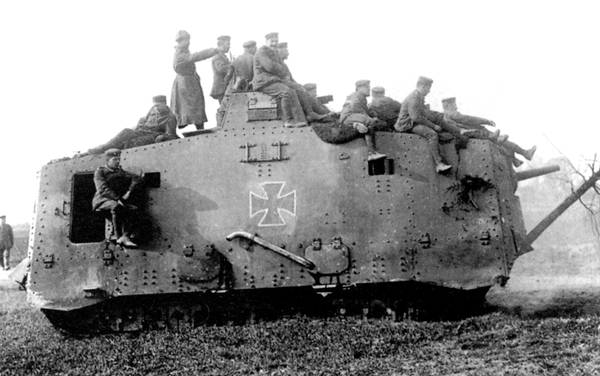
The Sturmpanzerwagen was more akin to the French St-Chamond and Schneider tanks than British designs. It required a crew of seventeen.
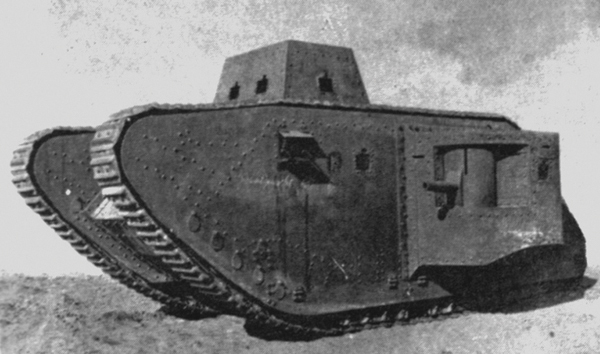
The A7V/U was being developed as a copy of the British rhomboid shape but did not go into production before the Armistice.
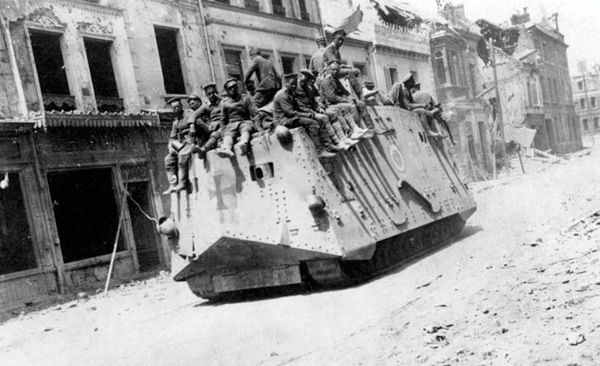
An AV7 tank at Roye 30 miles south-east of Amiens on 21 March 1918. The crew preferred to ride on the outside of the hull when not in combat.
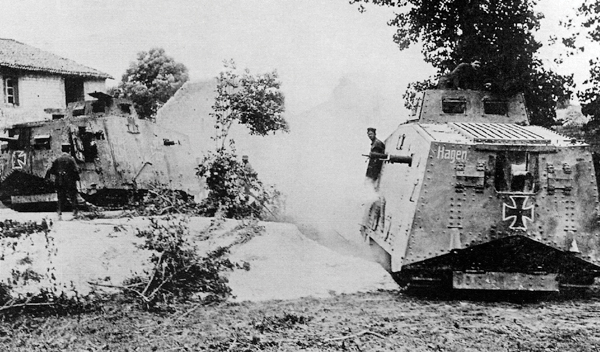
Two AV7s ready for action – this cumbersome tank was armed with a nose-mounted 57mm Maxim-Nordenfelt gun and six 7.92mm MG08 machine guns. Hagen was lost at Fremicourt during the summer of 1918.
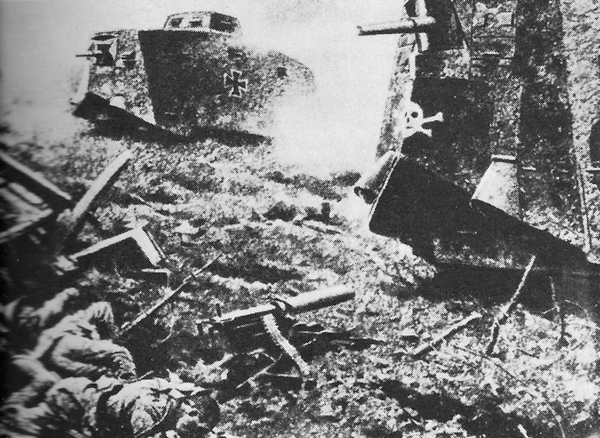
In this graphic dramatisation, AV7s bear down on Villers-Bretonneux.
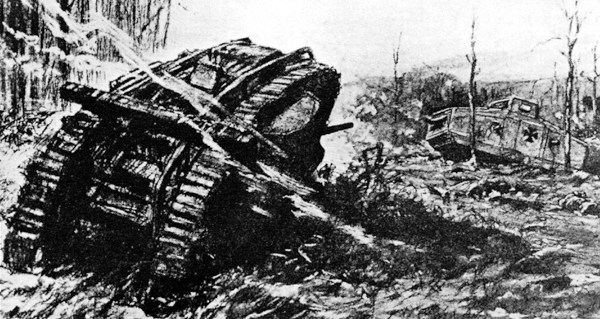
An artist’s impression of Lieutenant Frank Mitchell’s Mark IV male engaging an AV7 at Villers-Bretonneux.
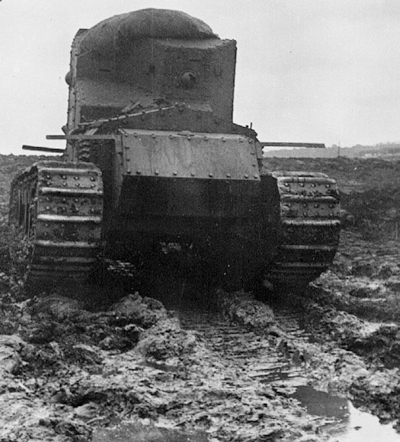
At Villers-Bretonneux the Whippet could not cope with the AV7’s heavy gun. Two were knocked out and two broke down.
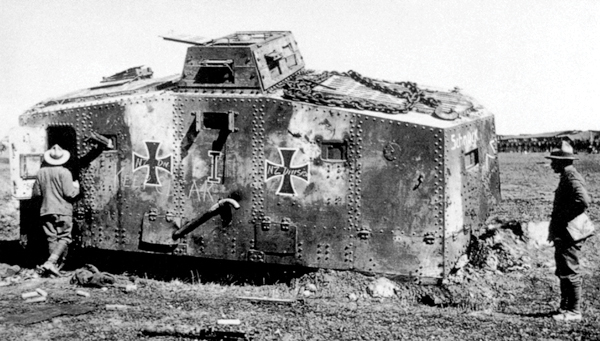
An AV7 named Schnuck was captured by the New Zealand Division on 31 August 1918 at Fremicourt. Its new owners have marked it ‘KEEP CLEAR’ and ‘NZ Division’.
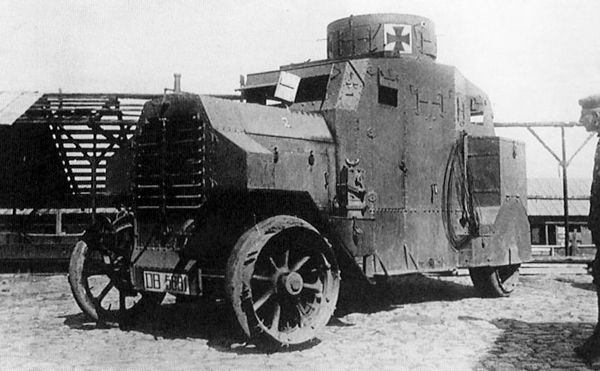
The Germans were also slow to appreciate the benefits of other types of armoured vehicle. Just twenty Ehrhardt armoured cars were built and these were sent to the Eastern Front.
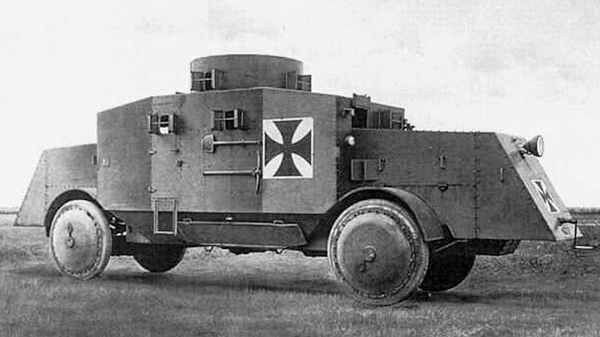
Developed in 1915, the Büssing A5P armoured car was massive and unwieldy. The German Army preferred the Ehrhardt design so just three A5Ps were ever built and these again were sent to the Eastern Front.